Taxation Law: Rental Income, Deductions, and ITAA 1997 Analysis
VerifiedAdded on 2023/06/04
|8
|2506
|216
Essay
AI Summary
This essay delves into the taxation laws surrounding rental income, focusing on what constitutes assessable income and permissible deductions for taxpayers. It examines the ordinary income concepts under Section 6-5 of the ITAA 1997 and the conditions for claiming deductions as per Section 8-1, emphasizing that expenses must be related to income generation and not be of a capital or private nature. The essay also discusses specific expenditures like interest on loans, council rates, and land tax, highlighting their deductibility when the property is genuinely available for rent. Case laws such as Scott v CT (1935) and Steele v FC of T (1999) are referenced to illustrate key principles, including the importance of establishing a clear connection between borrowed funds and income generation. The essay concludes that deductions are permissible only when the rental property generates assessable income or is sublet for generating taxable income, with the expenses needing to be directly related to the revenue-producing activities.
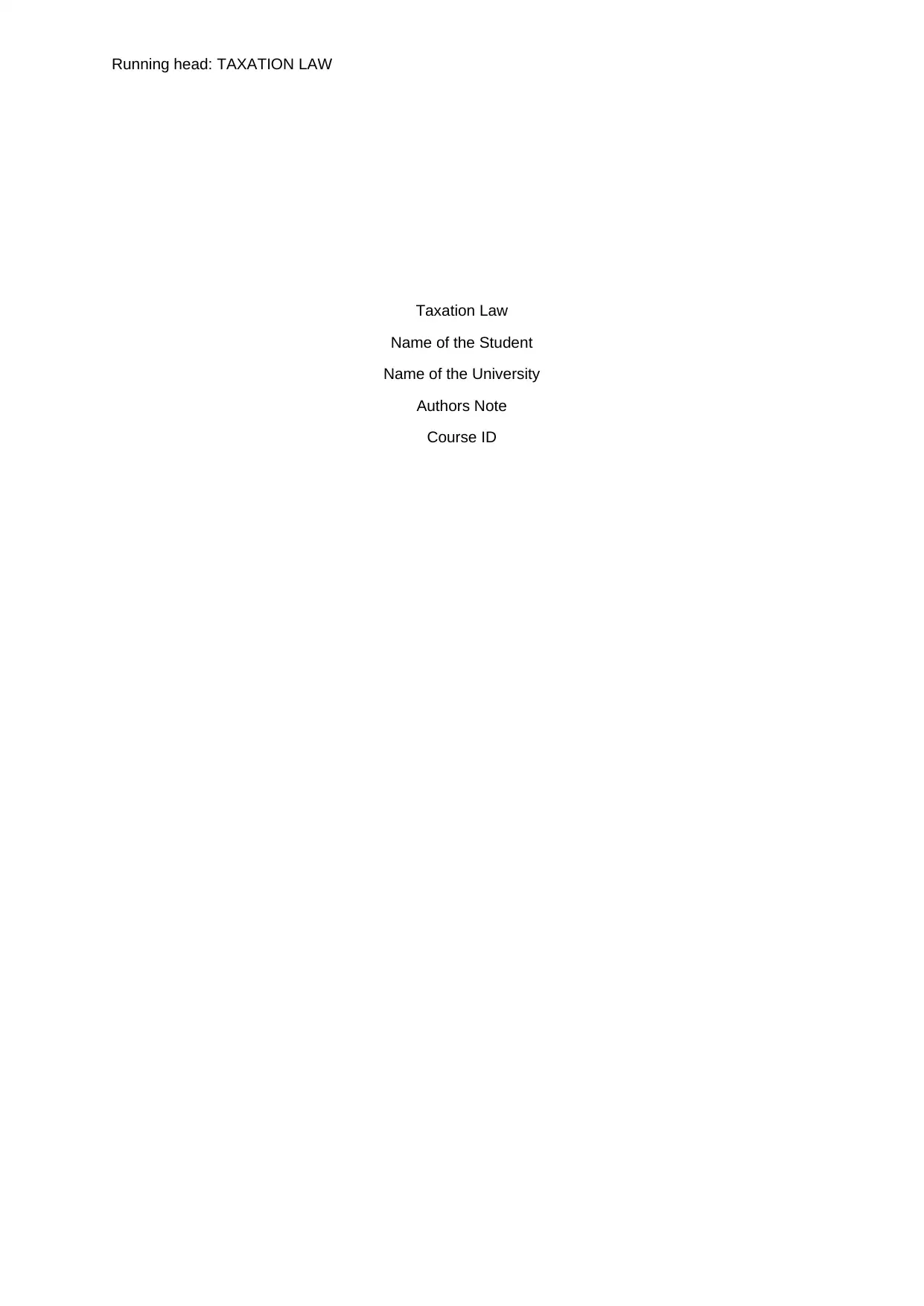
Running head: TAXATION LAW
Taxation Law
Name of the Student
Name of the University
Authors Note
Course ID
Taxation Law
Name of the Student
Name of the University
Authors Note
Course ID
Paraphrase This Document
Need a fresh take? Get an instant paraphrase of this document with our AI Paraphraser
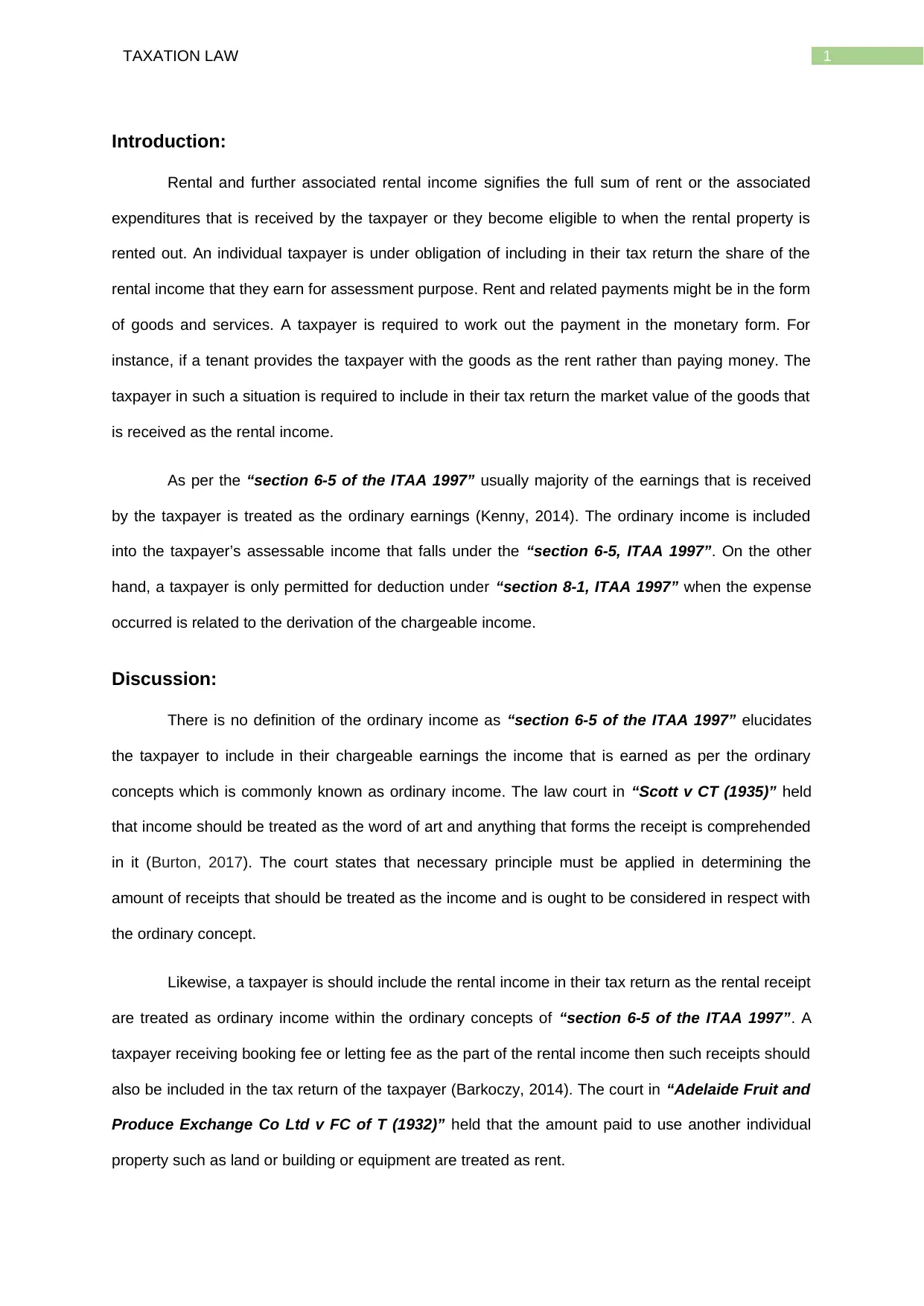
1TAXATION LAW
Introduction:
Rental and further associated rental income signifies the full sum of rent or the associated
expenditures that is received by the taxpayer or they become eligible to when the rental property is
rented out. An individual taxpayer is under obligation of including in their tax return the share of the
rental income that they earn for assessment purpose. Rent and related payments might be in the form
of goods and services. A taxpayer is required to work out the payment in the monetary form. For
instance, if a tenant provides the taxpayer with the goods as the rent rather than paying money. The
taxpayer in such a situation is required to include in their tax return the market value of the goods that
is received as the rental income.
As per the “section 6-5 of the ITAA 1997” usually majority of the earnings that is received
by the taxpayer is treated as the ordinary earnings (Kenny, 2014). The ordinary income is included
into the taxpayer’s assessable income that falls under the “section 6-5, ITAA 1997”. On the other
hand, a taxpayer is only permitted for deduction under “section 8-1, ITAA 1997” when the expense
occurred is related to the derivation of the chargeable income.
Discussion:
There is no definition of the ordinary income as “section 6-5 of the ITAA 1997” elucidates
the taxpayer to include in their chargeable earnings the income that is earned as per the ordinary
concepts which is commonly known as ordinary income. The law court in “Scott v CT (1935)” held
that income should be treated as the word of art and anything that forms the receipt is comprehended
in it (Burton, 2017). The court states that necessary principle must be applied in determining the
amount of receipts that should be treated as the income and is ought to be considered in respect with
the ordinary concept.
Likewise, a taxpayer is should include the rental income in their tax return as the rental receipt
are treated as ordinary income within the ordinary concepts of “section 6-5 of the ITAA 1997”. A
taxpayer receiving booking fee or letting fee as the part of the rental income then such receipts should
also be included in the tax return of the taxpayer (Barkoczy, 2014). The court in “Adelaide Fruit and
Produce Exchange Co Ltd v FC of T (1932)” held that the amount paid to use another individual
property such as land or building or equipment are treated as rent.
Introduction:
Rental and further associated rental income signifies the full sum of rent or the associated
expenditures that is received by the taxpayer or they become eligible to when the rental property is
rented out. An individual taxpayer is under obligation of including in their tax return the share of the
rental income that they earn for assessment purpose. Rent and related payments might be in the form
of goods and services. A taxpayer is required to work out the payment in the monetary form. For
instance, if a tenant provides the taxpayer with the goods as the rent rather than paying money. The
taxpayer in such a situation is required to include in their tax return the market value of the goods that
is received as the rental income.
As per the “section 6-5 of the ITAA 1997” usually majority of the earnings that is received
by the taxpayer is treated as the ordinary earnings (Kenny, 2014). The ordinary income is included
into the taxpayer’s assessable income that falls under the “section 6-5, ITAA 1997”. On the other
hand, a taxpayer is only permitted for deduction under “section 8-1, ITAA 1997” when the expense
occurred is related to the derivation of the chargeable income.
Discussion:
There is no definition of the ordinary income as “section 6-5 of the ITAA 1997” elucidates
the taxpayer to include in their chargeable earnings the income that is earned as per the ordinary
concepts which is commonly known as ordinary income. The law court in “Scott v CT (1935)” held
that income should be treated as the word of art and anything that forms the receipt is comprehended
in it (Burton, 2017). The court states that necessary principle must be applied in determining the
amount of receipts that should be treated as the income and is ought to be considered in respect with
the ordinary concept.
Likewise, a taxpayer is should include the rental income in their tax return as the rental receipt
are treated as ordinary income within the ordinary concepts of “section 6-5 of the ITAA 1997”. A
taxpayer receiving booking fee or letting fee as the part of the rental income then such receipts should
also be included in the tax return of the taxpayer (Barkoczy, 2014). The court in “Adelaide Fruit and
Produce Exchange Co Ltd v FC of T (1932)” held that the amount paid to use another individual
property such as land or building or equipment are treated as rent.
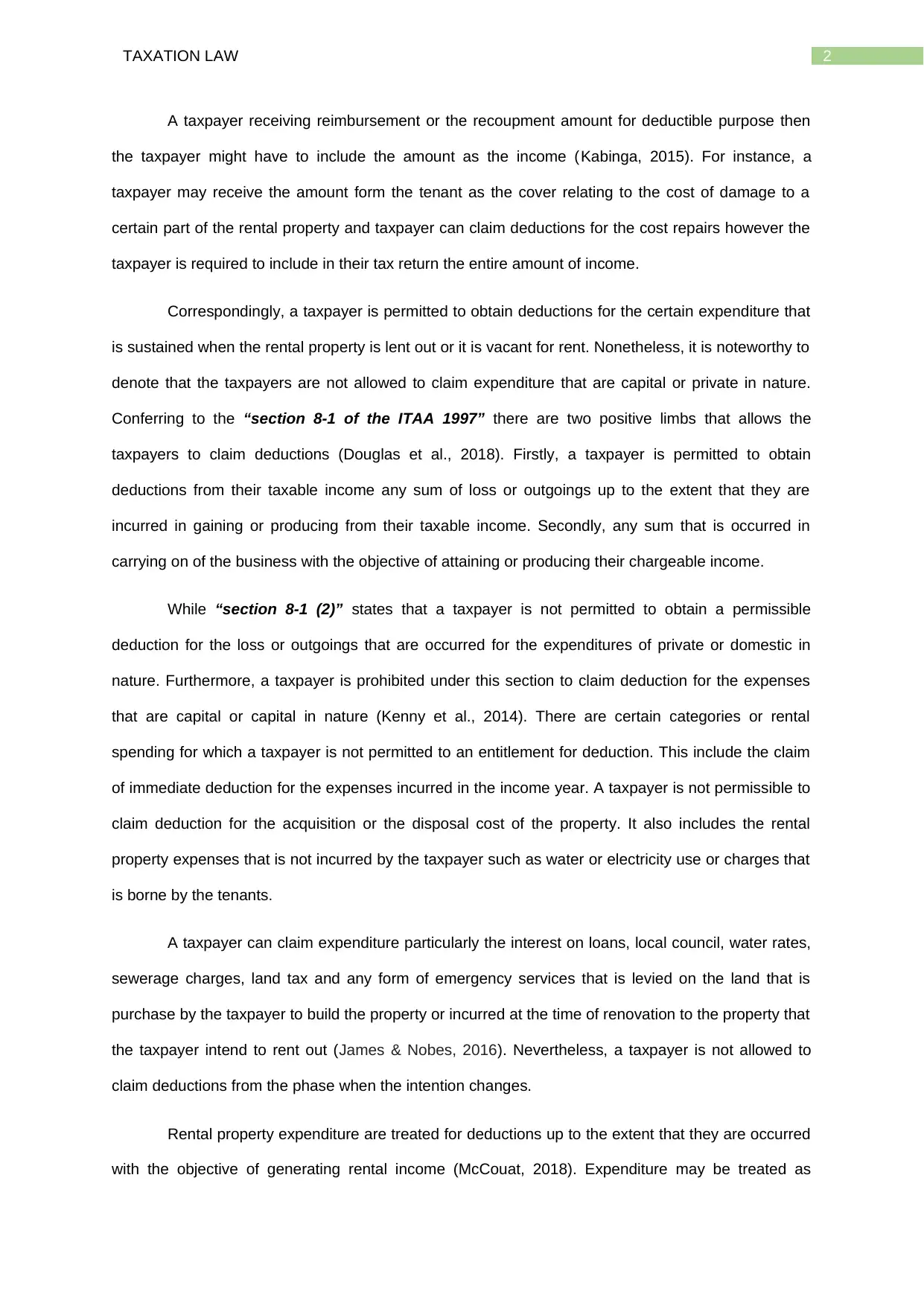
2TAXATION LAW
A taxpayer receiving reimbursement or the recoupment amount for deductible purpose then
the taxpayer might have to include the amount as the income (Kabinga, 2015). For instance, a
taxpayer may receive the amount form the tenant as the cover relating to the cost of damage to a
certain part of the rental property and taxpayer can claim deductions for the cost repairs however the
taxpayer is required to include in their tax return the entire amount of income.
Correspondingly, a taxpayer is permitted to obtain deductions for the certain expenditure that
is sustained when the rental property is lent out or it is vacant for rent. Nonetheless, it is noteworthy to
denote that the taxpayers are not allowed to claim expenditure that are capital or private in nature.
Conferring to the “section 8-1 of the ITAA 1997” there are two positive limbs that allows the
taxpayers to claim deductions (Douglas et al., 2018). Firstly, a taxpayer is permitted to obtain
deductions from their taxable income any sum of loss or outgoings up to the extent that they are
incurred in gaining or producing from their taxable income. Secondly, any sum that is occurred in
carrying on of the business with the objective of attaining or producing their chargeable income.
While “section 8-1 (2)” states that a taxpayer is not permitted to obtain a permissible
deduction for the loss or outgoings that are occurred for the expenditures of private or domestic in
nature. Furthermore, a taxpayer is prohibited under this section to claim deduction for the expenses
that are capital or capital in nature (Kenny et al., 2014). There are certain categories or rental
spending for which a taxpayer is not permitted to an entitlement for deduction. This include the claim
of immediate deduction for the expenses incurred in the income year. A taxpayer is not permissible to
claim deduction for the acquisition or the disposal cost of the property. It also includes the rental
property expenses that is not incurred by the taxpayer such as water or electricity use or charges that
is borne by the tenants.
A taxpayer can claim expenditure particularly the interest on loans, local council, water rates,
sewerage charges, land tax and any form of emergency services that is levied on the land that is
purchase by the taxpayer to build the property or incurred at the time of renovation to the property that
the taxpayer intend to rent out (James & Nobes, 2016). Nevertheless, a taxpayer is not allowed to
claim deductions from the phase when the intention changes.
Rental property expenditure are treated for deductions up to the extent that they are occurred
with the objective of generating rental income (McCouat, 2018). Expenditure may be treated as
A taxpayer receiving reimbursement or the recoupment amount for deductible purpose then
the taxpayer might have to include the amount as the income (Kabinga, 2015). For instance, a
taxpayer may receive the amount form the tenant as the cover relating to the cost of damage to a
certain part of the rental property and taxpayer can claim deductions for the cost repairs however the
taxpayer is required to include in their tax return the entire amount of income.
Correspondingly, a taxpayer is permitted to obtain deductions for the certain expenditure that
is sustained when the rental property is lent out or it is vacant for rent. Nonetheless, it is noteworthy to
denote that the taxpayers are not allowed to claim expenditure that are capital or private in nature.
Conferring to the “section 8-1 of the ITAA 1997” there are two positive limbs that allows the
taxpayers to claim deductions (Douglas et al., 2018). Firstly, a taxpayer is permitted to obtain
deductions from their taxable income any sum of loss or outgoings up to the extent that they are
incurred in gaining or producing from their taxable income. Secondly, any sum that is occurred in
carrying on of the business with the objective of attaining or producing their chargeable income.
While “section 8-1 (2)” states that a taxpayer is not permitted to obtain a permissible
deduction for the loss or outgoings that are occurred for the expenditures of private or domestic in
nature. Furthermore, a taxpayer is prohibited under this section to claim deduction for the expenses
that are capital or capital in nature (Kenny et al., 2014). There are certain categories or rental
spending for which a taxpayer is not permitted to an entitlement for deduction. This include the claim
of immediate deduction for the expenses incurred in the income year. A taxpayer is not permissible to
claim deduction for the acquisition or the disposal cost of the property. It also includes the rental
property expenses that is not incurred by the taxpayer such as water or electricity use or charges that
is borne by the tenants.
A taxpayer can claim expenditure particularly the interest on loans, local council, water rates,
sewerage charges, land tax and any form of emergency services that is levied on the land that is
purchase by the taxpayer to build the property or incurred at the time of renovation to the property that
the taxpayer intend to rent out (James & Nobes, 2016). Nevertheless, a taxpayer is not allowed to
claim deductions from the phase when the intention changes.
Rental property expenditure are treated for deductions up to the extent that they are occurred
with the objective of generating rental income (McCouat, 2018). Expenditure may be treated as
⊘ This is a preview!⊘
Do you want full access?
Subscribe today to unlock all pages.

Trusted by 1+ million students worldwide
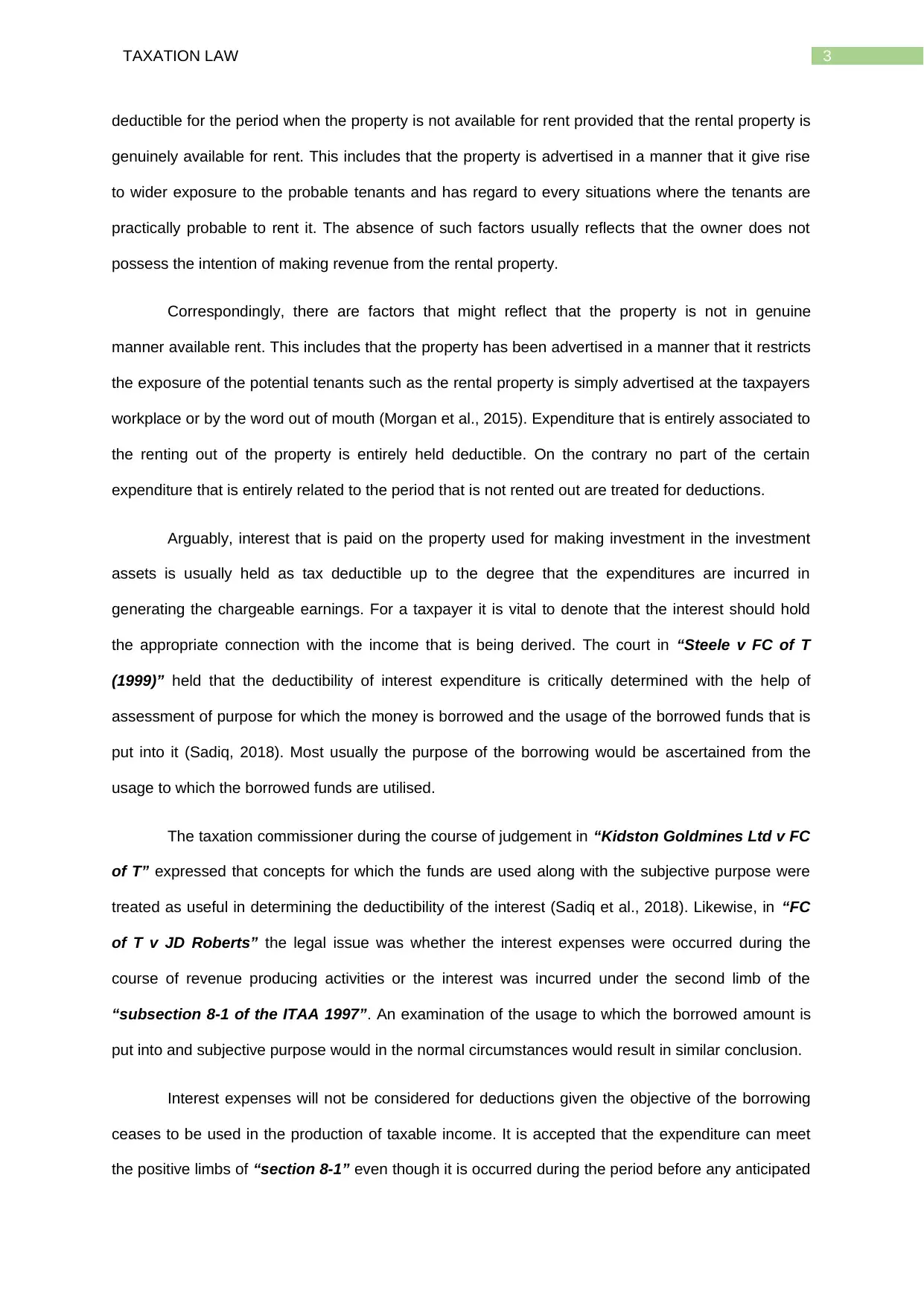
3TAXATION LAW
deductible for the period when the property is not available for rent provided that the rental property is
genuinely available for rent. This includes that the property is advertised in a manner that it give rise
to wider exposure to the probable tenants and has regard to every situations where the tenants are
practically probable to rent it. The absence of such factors usually reflects that the owner does not
possess the intention of making revenue from the rental property.
Correspondingly, there are factors that might reflect that the property is not in genuine
manner available rent. This includes that the property has been advertised in a manner that it restricts
the exposure of the potential tenants such as the rental property is simply advertised at the taxpayers
workplace or by the word out of mouth (Morgan et al., 2015). Expenditure that is entirely associated to
the renting out of the property is entirely held deductible. On the contrary no part of the certain
expenditure that is entirely related to the period that is not rented out are treated for deductions.
Arguably, interest that is paid on the property used for making investment in the investment
assets is usually held as tax deductible up to the degree that the expenditures are incurred in
generating the chargeable earnings. For a taxpayer it is vital to denote that the interest should hold
the appropriate connection with the income that is being derived. The court in “Steele v FC of T
(1999)” held that the deductibility of interest expenditure is critically determined with the help of
assessment of purpose for which the money is borrowed and the usage of the borrowed funds that is
put into it (Sadiq, 2018). Most usually the purpose of the borrowing would be ascertained from the
usage to which the borrowed funds are utilised.
The taxation commissioner during the course of judgement in “Kidston Goldmines Ltd v FC
of T” expressed that concepts for which the funds are used along with the subjective purpose were
treated as useful in determining the deductibility of the interest (Sadiq et al., 2018). Likewise, in “FC
of T v JD Roberts” the legal issue was whether the interest expenses were occurred during the
course of revenue producing activities or the interest was incurred under the second limb of the
“subsection 8-1 of the ITAA 1997”. An examination of the usage to which the borrowed amount is
put into and subjective purpose would in the normal circumstances would result in similar conclusion.
Interest expenses will not be considered for deductions given the objective of the borrowing
ceases to be used in the production of taxable income. It is accepted that the expenditure can meet
the positive limbs of “section 8-1” even though it is occurred during the period before any anticipated
deductible for the period when the property is not available for rent provided that the rental property is
genuinely available for rent. This includes that the property is advertised in a manner that it give rise
to wider exposure to the probable tenants and has regard to every situations where the tenants are
practically probable to rent it. The absence of such factors usually reflects that the owner does not
possess the intention of making revenue from the rental property.
Correspondingly, there are factors that might reflect that the property is not in genuine
manner available rent. This includes that the property has been advertised in a manner that it restricts
the exposure of the potential tenants such as the rental property is simply advertised at the taxpayers
workplace or by the word out of mouth (Morgan et al., 2015). Expenditure that is entirely associated to
the renting out of the property is entirely held deductible. On the contrary no part of the certain
expenditure that is entirely related to the period that is not rented out are treated for deductions.
Arguably, interest that is paid on the property used for making investment in the investment
assets is usually held as tax deductible up to the degree that the expenditures are incurred in
generating the chargeable earnings. For a taxpayer it is vital to denote that the interest should hold
the appropriate connection with the income that is being derived. The court in “Steele v FC of T
(1999)” held that the deductibility of interest expenditure is critically determined with the help of
assessment of purpose for which the money is borrowed and the usage of the borrowed funds that is
put into it (Sadiq, 2018). Most usually the purpose of the borrowing would be ascertained from the
usage to which the borrowed funds are utilised.
The taxation commissioner during the course of judgement in “Kidston Goldmines Ltd v FC
of T” expressed that concepts for which the funds are used along with the subjective purpose were
treated as useful in determining the deductibility of the interest (Sadiq et al., 2018). Likewise, in “FC
of T v JD Roberts” the legal issue was whether the interest expenses were occurred during the
course of revenue producing activities or the interest was incurred under the second limb of the
“subsection 8-1 of the ITAA 1997”. An examination of the usage to which the borrowed amount is
put into and subjective purpose would in the normal circumstances would result in similar conclusion.
Interest expenses will not be considered for deductions given the objective of the borrowing
ceases to be used in the production of taxable income. It is accepted that the expenditure can meet
the positive limbs of “section 8-1” even though it is occurred during the period before any anticipated
Paraphrase This Document
Need a fresh take? Get an instant paraphrase of this document with our AI Paraphraser
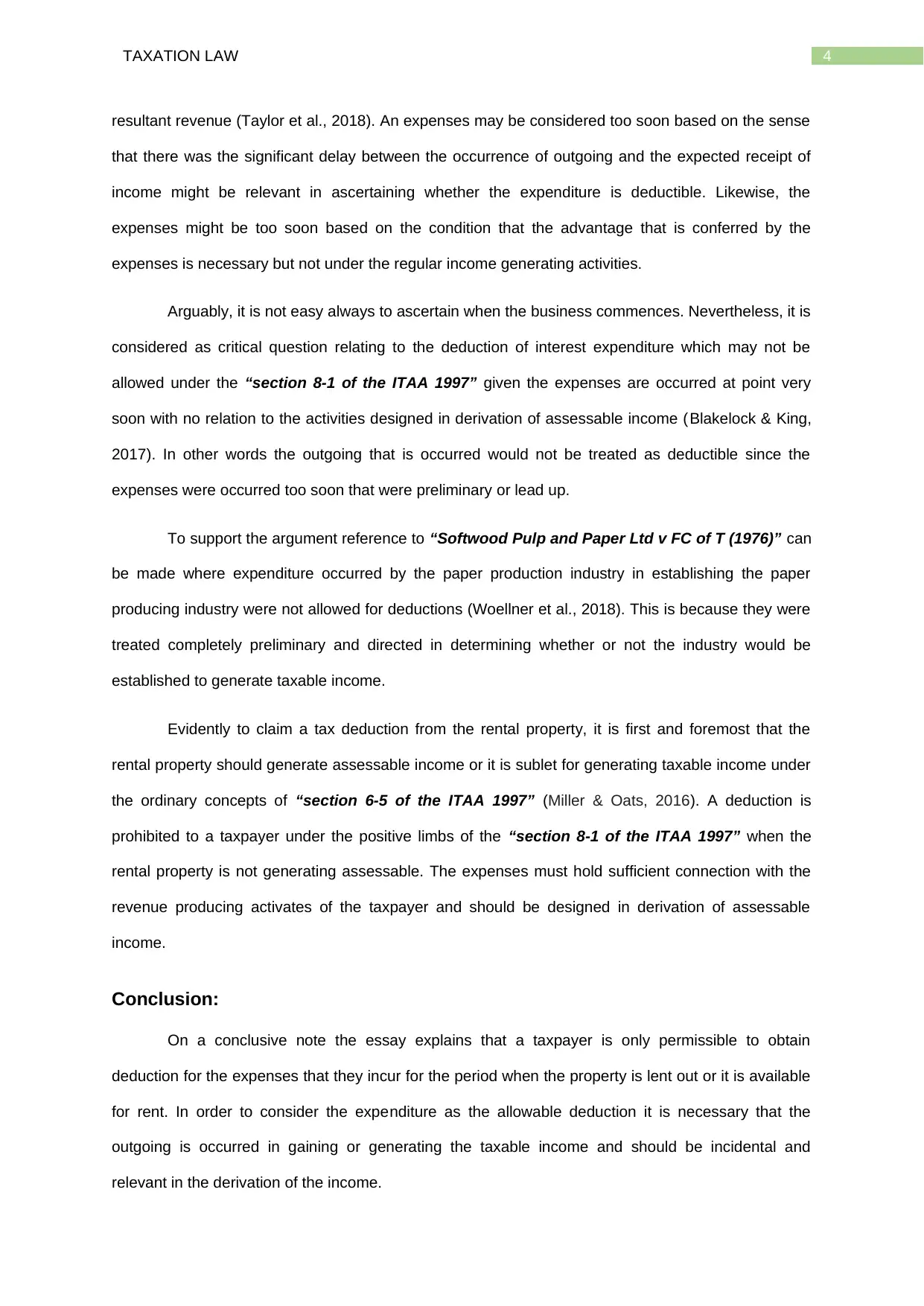
4TAXATION LAW
resultant revenue (Taylor et al., 2018). An expenses may be considered too soon based on the sense
that there was the significant delay between the occurrence of outgoing and the expected receipt of
income might be relevant in ascertaining whether the expenditure is deductible. Likewise, the
expenses might be too soon based on the condition that the advantage that is conferred by the
expenses is necessary but not under the regular income generating activities.
Arguably, it is not easy always to ascertain when the business commences. Nevertheless, it is
considered as critical question relating to the deduction of interest expenditure which may not be
allowed under the “section 8-1 of the ITAA 1997” given the expenses are occurred at point very
soon with no relation to the activities designed in derivation of assessable income (Blakelock & King,
2017). In other words the outgoing that is occurred would not be treated as deductible since the
expenses were occurred too soon that were preliminary or lead up.
To support the argument reference to “Softwood Pulp and Paper Ltd v FC of T (1976)” can
be made where expenditure occurred by the paper production industry in establishing the paper
producing industry were not allowed for deductions (Woellner et al., 2018). This is because they were
treated completely preliminary and directed in determining whether or not the industry would be
established to generate taxable income.
Evidently to claim a tax deduction from the rental property, it is first and foremost that the
rental property should generate assessable income or it is sublet for generating taxable income under
the ordinary concepts of “section 6-5 of the ITAA 1997” (Miller & Oats, 2016). A deduction is
prohibited to a taxpayer under the positive limbs of the “section 8-1 of the ITAA 1997” when the
rental property is not generating assessable. The expenses must hold sufficient connection with the
revenue producing activates of the taxpayer and should be designed in derivation of assessable
income.
Conclusion:
On a conclusive note the essay explains that a taxpayer is only permissible to obtain
deduction for the expenses that they incur for the period when the property is lent out or it is available
for rent. In order to consider the expenditure as the allowable deduction it is necessary that the
outgoing is occurred in gaining or generating the taxable income and should be incidental and
relevant in the derivation of the income.
resultant revenue (Taylor et al., 2018). An expenses may be considered too soon based on the sense
that there was the significant delay between the occurrence of outgoing and the expected receipt of
income might be relevant in ascertaining whether the expenditure is deductible. Likewise, the
expenses might be too soon based on the condition that the advantage that is conferred by the
expenses is necessary but not under the regular income generating activities.
Arguably, it is not easy always to ascertain when the business commences. Nevertheless, it is
considered as critical question relating to the deduction of interest expenditure which may not be
allowed under the “section 8-1 of the ITAA 1997” given the expenses are occurred at point very
soon with no relation to the activities designed in derivation of assessable income (Blakelock & King,
2017). In other words the outgoing that is occurred would not be treated as deductible since the
expenses were occurred too soon that were preliminary or lead up.
To support the argument reference to “Softwood Pulp and Paper Ltd v FC of T (1976)” can
be made where expenditure occurred by the paper production industry in establishing the paper
producing industry were not allowed for deductions (Woellner et al., 2018). This is because they were
treated completely preliminary and directed in determining whether or not the industry would be
established to generate taxable income.
Evidently to claim a tax deduction from the rental property, it is first and foremost that the
rental property should generate assessable income or it is sublet for generating taxable income under
the ordinary concepts of “section 6-5 of the ITAA 1997” (Miller & Oats, 2016). A deduction is
prohibited to a taxpayer under the positive limbs of the “section 8-1 of the ITAA 1997” when the
rental property is not generating assessable. The expenses must hold sufficient connection with the
revenue producing activates of the taxpayer and should be designed in derivation of assessable
income.
Conclusion:
On a conclusive note the essay explains that a taxpayer is only permissible to obtain
deduction for the expenses that they incur for the period when the property is lent out or it is available
for rent. In order to consider the expenditure as the allowable deduction it is necessary that the
outgoing is occurred in gaining or generating the taxable income and should be incidental and
relevant in the derivation of the income.

5TAXATION LAW
In other words, for an expense to fall within the initial portion of the subsection it is necessary
that the expenses should be both sufficient and necessary that the circumstances of outgoing must be
found in whatsoever is production of taxable income. Evidently, the expenses and interest for the first
four months of the rental property runs counter to the matching principle since the property was not
generating any taxable income during that time.
In other words, for an expense to fall within the initial portion of the subsection it is necessary
that the expenses should be both sufficient and necessary that the circumstances of outgoing must be
found in whatsoever is production of taxable income. Evidently, the expenses and interest for the first
four months of the rental property runs counter to the matching principle since the property was not
generating any taxable income during that time.
⊘ This is a preview!⊘
Do you want full access?
Subscribe today to unlock all pages.

Trusted by 1+ million students worldwide
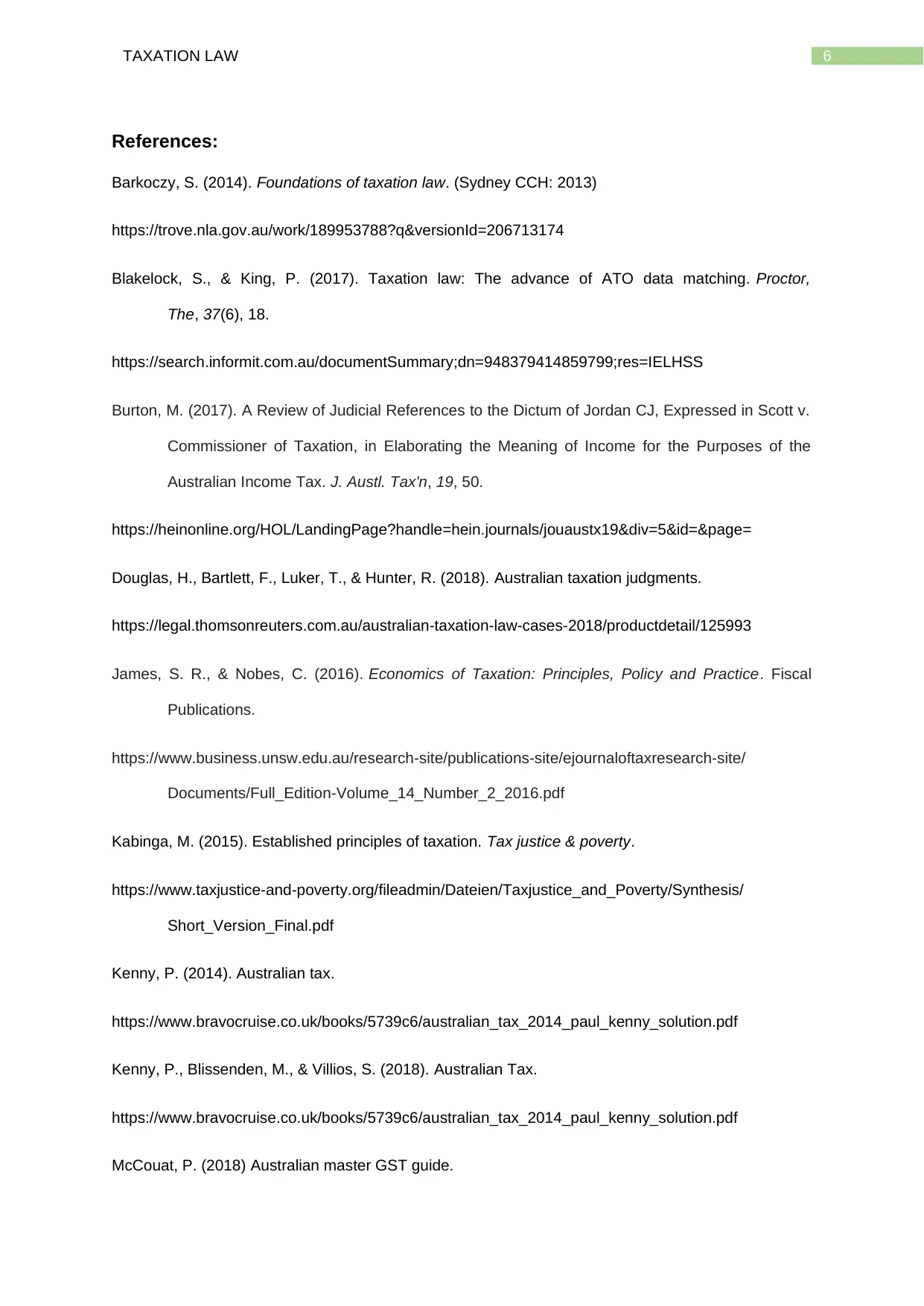
6TAXATION LAW
References:
Barkoczy, S. (2014). Foundations of taxation law. (Sydney CCH: 2013)
https://trove.nla.gov.au/work/189953788?q&versionId=206713174
Blakelock, S., & King, P. (2017). Taxation law: The advance of ATO data matching. Proctor,
The, 37(6), 18.
https://search.informit.com.au/documentSummary;dn=948379414859799;res=IELHSS
Burton, M. (2017). A Review of Judicial References to the Dictum of Jordan CJ, Expressed in Scott v.
Commissioner of Taxation, in Elaborating the Meaning of Income for the Purposes of the
Australian Income Tax. J. Austl. Tax'n, 19, 50.
https://heinonline.org/HOL/LandingPage?handle=hein.journals/jouaustx19&div=5&id=&page=
Douglas, H., Bartlett, F., Luker, T., & Hunter, R. (2018). Australian taxation judgments.
https://legal.thomsonreuters.com.au/australian-taxation-law-cases-2018/productdetail/125993
James, S. R., & Nobes, C. (2016). Economics of Taxation: Principles, Policy and Practice. Fiscal
Publications.
https://www.business.unsw.edu.au/research-site/publications-site/ejournaloftaxresearch-site/
Documents/Full_Edition-Volume_14_Number_2_2016.pdf
Kabinga, M. (2015). Established principles of taxation. Tax justice & poverty.
https://www.taxjustice-and-poverty.org/fileadmin/Dateien/Taxjustice_and_Poverty/Synthesis/
Short_Version_Final.pdf
Kenny, P. (2014). Australian tax.
https://www.bravocruise.co.uk/books/5739c6/australian_tax_2014_paul_kenny_solution.pdf
Kenny, P., Blissenden, M., & Villios, S. (2018). Australian Tax.
https://www.bravocruise.co.uk/books/5739c6/australian_tax_2014_paul_kenny_solution.pdf
McCouat, P. (2018) Australian master GST guide.
References:
Barkoczy, S. (2014). Foundations of taxation law. (Sydney CCH: 2013)
https://trove.nla.gov.au/work/189953788?q&versionId=206713174
Blakelock, S., & King, P. (2017). Taxation law: The advance of ATO data matching. Proctor,
The, 37(6), 18.
https://search.informit.com.au/documentSummary;dn=948379414859799;res=IELHSS
Burton, M. (2017). A Review of Judicial References to the Dictum of Jordan CJ, Expressed in Scott v.
Commissioner of Taxation, in Elaborating the Meaning of Income for the Purposes of the
Australian Income Tax. J. Austl. Tax'n, 19, 50.
https://heinonline.org/HOL/LandingPage?handle=hein.journals/jouaustx19&div=5&id=&page=
Douglas, H., Bartlett, F., Luker, T., & Hunter, R. (2018). Australian taxation judgments.
https://legal.thomsonreuters.com.au/australian-taxation-law-cases-2018/productdetail/125993
James, S. R., & Nobes, C. (2016). Economics of Taxation: Principles, Policy and Practice. Fiscal
Publications.
https://www.business.unsw.edu.au/research-site/publications-site/ejournaloftaxresearch-site/
Documents/Full_Edition-Volume_14_Number_2_2016.pdf
Kabinga, M. (2015). Established principles of taxation. Tax justice & poverty.
https://www.taxjustice-and-poverty.org/fileadmin/Dateien/Taxjustice_and_Poverty/Synthesis/
Short_Version_Final.pdf
Kenny, P. (2014). Australian tax.
https://www.bravocruise.co.uk/books/5739c6/australian_tax_2014_paul_kenny_solution.pdf
Kenny, P., Blissenden, M., & Villios, S. (2018). Australian Tax.
https://www.bravocruise.co.uk/books/5739c6/australian_tax_2014_paul_kenny_solution.pdf
McCouat, P. (2018) Australian master GST guide.
Paraphrase This Document
Need a fresh take? Get an instant paraphrase of this document with our AI Paraphraser
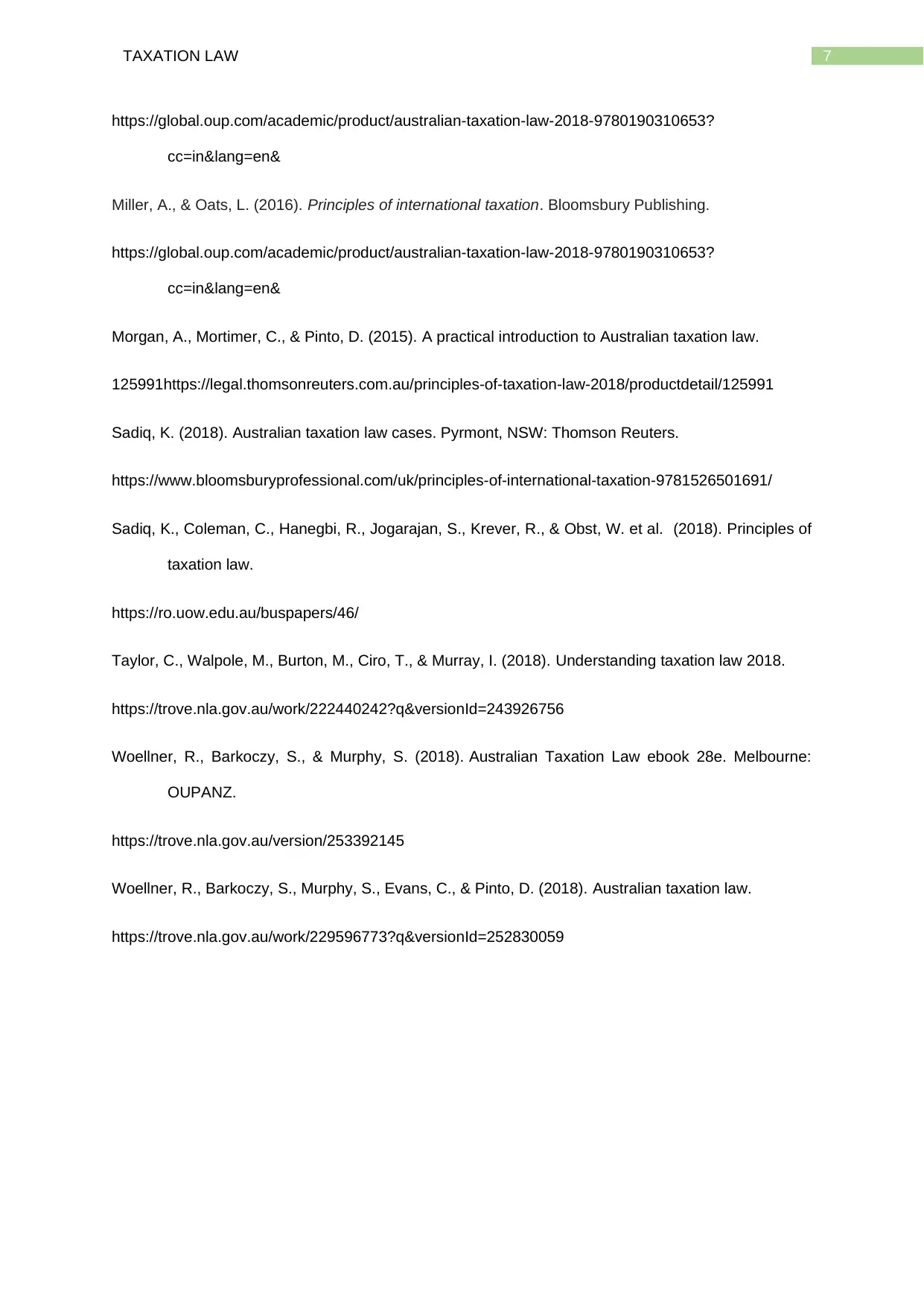
7TAXATION LAW
https://global.oup.com/academic/product/australian-taxation-law-2018-9780190310653?
cc=in&lang=en&
Miller, A., & Oats, L. (2016). Principles of international taxation. Bloomsbury Publishing.
https://global.oup.com/academic/product/australian-taxation-law-2018-9780190310653?
cc=in&lang=en&
Morgan, A., Mortimer, C., & Pinto, D. (2015). A practical introduction to Australian taxation law.
125991https://legal.thomsonreuters.com.au/principles-of-taxation-law-2018/productdetail/125991
Sadiq, K. (2018). Australian taxation law cases. Pyrmont, NSW: Thomson Reuters.
https://www.bloomsburyprofessional.com/uk/principles-of-international-taxation-9781526501691/
Sadiq, K., Coleman, C., Hanegbi, R., Jogarajan, S., Krever, R., & Obst, W. et al. (2018). Principles of
taxation law.
https://ro.uow.edu.au/buspapers/46/
Taylor, C., Walpole, M., Burton, M., Ciro, T., & Murray, I. (2018). Understanding taxation law 2018.
https://trove.nla.gov.au/work/222440242?q&versionId=243926756
Woellner, R., Barkoczy, S., & Murphy, S. (2018). Australian Taxation Law ebook 28e. Melbourne:
OUPANZ.
https://trove.nla.gov.au/version/253392145
Woellner, R., Barkoczy, S., Murphy, S., Evans, C., & Pinto, D. (2018). Australian taxation law.
https://trove.nla.gov.au/work/229596773?q&versionId=252830059
https://global.oup.com/academic/product/australian-taxation-law-2018-9780190310653?
cc=in&lang=en&
Miller, A., & Oats, L. (2016). Principles of international taxation. Bloomsbury Publishing.
https://global.oup.com/academic/product/australian-taxation-law-2018-9780190310653?
cc=in&lang=en&
Morgan, A., Mortimer, C., & Pinto, D. (2015). A practical introduction to Australian taxation law.
125991https://legal.thomsonreuters.com.au/principles-of-taxation-law-2018/productdetail/125991
Sadiq, K. (2018). Australian taxation law cases. Pyrmont, NSW: Thomson Reuters.
https://www.bloomsburyprofessional.com/uk/principles-of-international-taxation-9781526501691/
Sadiq, K., Coleman, C., Hanegbi, R., Jogarajan, S., Krever, R., & Obst, W. et al. (2018). Principles of
taxation law.
https://ro.uow.edu.au/buspapers/46/
Taylor, C., Walpole, M., Burton, M., Ciro, T., & Murray, I. (2018). Understanding taxation law 2018.
https://trove.nla.gov.au/work/222440242?q&versionId=243926756
Woellner, R., Barkoczy, S., & Murphy, S. (2018). Australian Taxation Law ebook 28e. Melbourne:
OUPANZ.
https://trove.nla.gov.au/version/253392145
Woellner, R., Barkoczy, S., Murphy, S., Evans, C., & Pinto, D. (2018). Australian taxation law.
https://trove.nla.gov.au/work/229596773?q&versionId=252830059
1 out of 8
Related Documents
Your All-in-One AI-Powered Toolkit for Academic Success.
+13062052269
info@desklib.com
Available 24*7 on WhatsApp / Email
![[object Object]](/_next/static/media/star-bottom.7253800d.svg)
Unlock your academic potential
Copyright © 2020–2025 A2Z Services. All Rights Reserved. Developed and managed by ZUCOL.




